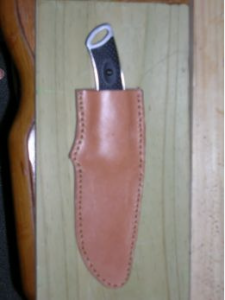Do you want to get into leatherwork, but aren’t sure where to start? Maybe you have picked a project that you want to make, and aren’t sure what leather to use or where to get it. This page will give you some guidelines for choosing the right leather to make the best project possible.
1) Determine what you want to make. The project will give you an idea where to start.
2) If the project needs to be form-fitting, like a molded knife sheath or a holster, you want a leather that can be wet-molded or formed to the shape of an object. Leather cannot be formed when dry, but becomes much more flexible when wet and can take on a shape that it will retain when dry. Vegetable-tanned (veg-tan or oak-tanned) leather is generally required for wet-molding. It is the most expensive leather, depending on the part of the hide, but essential for wet-molding. Veg-tanned leather is also known as tooling leather. If you want to tool the leather, then you need veg-tan as well.
3) If you are making a bag of some sort, clothing, or leather art where a close molded-type fit is not necessary, almost any type of leather will do. In this case, you can choose either veg-tan or chrome-tanned leather. Chrome-tan tends to be much cheaper and easier to find. Most of the cheaper, commonly-found leather is chrome-tanned. Many companies and hobby-type stores carry inexpensive bulk scraps of leather that will work very well for these types of items such as the veg tanned lot below.
Springfield Leather Company’s 5lb Natural Vegetable Tan Leather Scrap
4) If the project is a holster, knife sheath, or something else where the leather may interact with metal, consider using veg-tan leather instead of chrome-tan. While the decision isn’t a huge deal, oak-tan tends to react less with metal. There are some makers who prefer to use chrome-tanned leather instead of veg-tan for these items, but they are a rather distinct minority. Basically, it won’t hurt to use chrome-tan to practice and for some items, but for the best results, use veg-tanned leather.
5) If using the more expensive veg-tan leather, pick a part of the hide that corresponds to the size or thickness of the project. Shoulders are usually used for belts and other thicker pieces. Sides are used for parts that require strength and appearance, but not as much thickness as the shoulders. Bellies are the worst quality and tend to stretch, but are by far the cheapest leather cut. Still, they are quite useful if you want to make a smaller item that doesn’t need great strength. Belly leather is also great to practice as a beginner. You can make very useful items and, if you mess up, there is little expense.
6) Consider the thickness that you need. Leather thickness is measured in ounces. A 2 or 3 oz. piece is thin and fairly pliable, whereas a 10 oz. piece is thick and heavy and could be used for a large holster or even for saddles and bridles. Consider a 2-3 oz piece for small projects such as bookmarks, 5-8 oz. pieces for knife sheaths, belt pouches and similar and maybe 8-10 oz. leather for holsters or belts.
7) Latigo is another form of normally chrome-tanned leather (although some latigo is veg tan) that is useful for projects such as larger cases for cameras, pool cues, and similar. It is cheaper than veg-tan as well. Latigo is very useful for items where thick leather is essential, but a closely molded fit is unnecessary. Items like pool cue cases, harmonica cases, and similar are often made with latigo.
It is getting a little harder to find good leather for hobby leatherworking, but it is still available. Amazon.com has some of the cheapest prices around. I have dealt with Leather Unlimited, and have no complaints. Many of the larger sources only sell very large amounts of leather – greater than any hobbyist is likely to use. You can get smaller pieces at hobby shops. They are a lot more expensive for the size, but considerably cheaper than buying a large piece. The sheath shown was constructed from one of these smaller pieces.
If you are only interested in one smaller project, a good place to start is to go to a local hobby shop or Amazon and buy a smaller 8 1/2″x11″ to 1 sq. ft piece of veg-tan leather. Amazon.com carries these small Tooling Leather Pieces and the Springfield Leather Company 12″x12″ Pre-Cut Hermann Oak Leather Tooling Pieces 8-9oz
.
 |  |
| Tandy Leather Factory Tooling Piece, 8.5 by 11-Inch | Springfield Leather Company 12"x12" Pre-Cut Hermann Oak Leather Tooling Pieces 8-9oz |
If you have any real interest in giving leatherworking a try, consider a larger piece that will allow some margin for mistakes and provide enough leather for a couple small projects such as Springfield Leather Company 24″x24″ Pre-Cut Hermann Oak Leather Tooling Pieces 8-9oz, also available at Amazon
. Another option is to buy larger Scrap Lace Leather
pieces that are excellent for practice.
 |  |
| Springfield Leather Company 24"x24" Pre-Cut Hermann Oak Leather Tooling Pieces 7-8oz | Springfield Leather Company 18"x18" Pre-Cut Hermann Oak Leather Tooling Pieces 6-7oz |
If you have large projects you want to try or know that you want to work on several pieces, you will need a lot of leather and buying a lot of small pieces will nearly bankrupt you, so strongly consider buying a side, such as the Oak Cowhide Side 5/6 oz if you are interested in molding or tooling the leather or a softer chrome-tanned Natural Finish Cow leather, 20 Square Foot
if you are interested in making leather bags or purses.
 |  |
| Oak Cowhide Side 5/6 oz | Natural Finish Cow leather, 20 Square Foot |
Leatherworking is a great hobby. Have fun with it!

